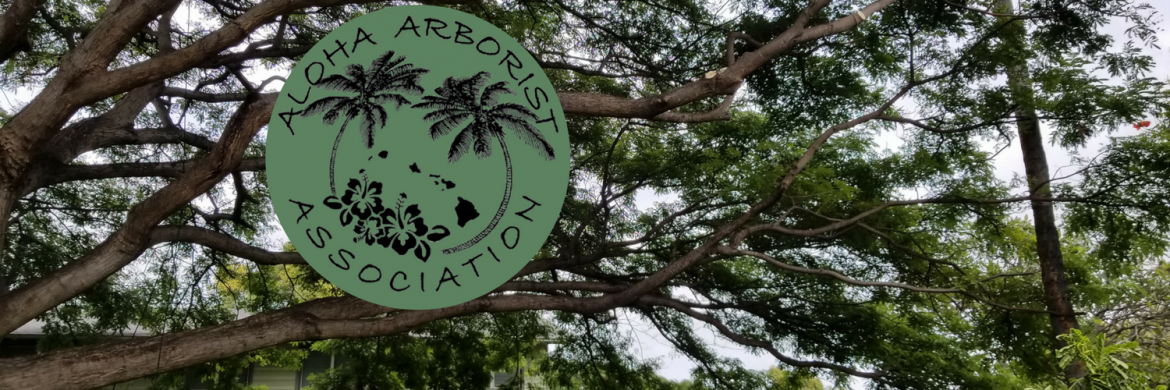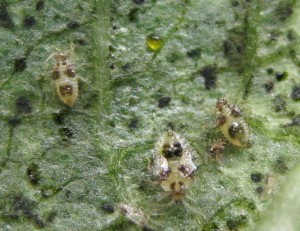Hosts: Sugarcane, palms (coconut, betelnut), papaya Distribution: Most of Micronesia and Hawaii. Native to New Guinea. Symptoms: Tunnels in the interior of the stem. The entrance is usually plugged with plant fibers. In coconuts, the stem is weakened to the point of palm failure in high winds. In betelnut, the weevils frequently bore near the …
Category: News
Jun 30
Pest of the Month October 2011 – Ohia Psyllid
Ohia Psyllid (several native Hawaiian species of the Family Psyllidae) Host: Ohia Distribution: Native to Hawaii Symptoms: Circular, conical, or convex galls on leaves, particularly new growth Management: Biological control by other native species (Sympiesis sp.) Because the ohia psyllids are native insects, avoid the use of pesticides as they or their parasites could become …
Jun 27
Pest of the Month September 2011 – Bacterial Leaf Blight of Panax
Host: Panax Symptoms: Lesions on young leaves have a water-soaked appearance. Mature lesions have dried brown centers and dark-colored or black margins. Lesions are sometimes surrounded by diffuse purplish or reddish halos. Blighted leaves may curl and drop prematurely. Spread by: Splashing water or windblown rain. Management: When propagating, use pathogen-free plant material. Do not …
Jun 27
Pest of the Month August 2011 – Chinese Rose Beetle
Distribution: Originally from Japan and Taiwan. Widespread through southeast Asia and Pacific Islands Hosts: Over 250 plants. Wide variety o f ornamentals and cultivated crops. Damage: Lace-like or shot with holes appearance on leaves caused by adults Management: Insignificant biological control. Green muscardine fungus destroys many larvae and adults during wet season. Pesticides not noted. Per …
Jun 27
Pest of the Month July 2011 – Coconut Mealybug
Distribution: North, Central, and South America, Europe, Asia, Oceania, and Africa. Hosts: Dracaena, sago palm, Heliconia, avocado, banana, orchids, palms (dwarf date, Washingtonia, Chamaedorea, queen palm, & Rhapis), Coffea spp., Citrus spp., potato, & ginger Damage: Adult females and immatures feed on sap. Honeydew secretions may lead to black sooty mold, which can result in …
Jun 27
Pest of the Month June 2011 – Lightning Injury to Plants
Affects: Any plant, particularly tall-standing, erect plants (like trees and palms) Symptoms include: rapid wilting or collapse of plants or stems in combination with structural damage or carbonization (burning) of the internal stem tissues, premature mass dropping of green fruit, burns or strange scars on plants or organs, roots appear blackened or cooked, interior plant …
Jun 27
Pest of the Month May 2011 – Giant Palm Weevil (Pest Alert)
Distribution: from South Carolina south to the Florida Keys and west toTexas. Native to Florida. Hosts: Canary date palm, date palm, sabal palm, fishtail palm, coconut, latan palms, royal palm, and Washingtonia spp. Stressed, damaged, pruned, and recently transplanted palms are the most susceptible. Symptoms: General decline of young fronds, older fronds may begin to …
Jun 27
Pest of the Month April 2011 – Broad Mite
Hosts: Guava, macadamia, mango, and Plumeria Distribution: All of the major Hawaiian islands, Australia, Asia, Africa, North America, South America, and the Pacific Islands Damage: Terminal leaf and flower buds become cupped and distorted, reduction in photosynthesis, corky brown areas between the main veins on the underside of leaves. Management: Biological control through locally occurring …
Jun 27
Pest of the Month March 2011 – Spiraling Whitefly
Hosts: Recorded on 38 genera of plants from 27 plant families and over 100 different species. Common on avocado, breadfruit, citrus, coconut, kamani, Indian banyan, macadamia, mango, palm, paperbark, plumeria, sea grape, and tropical almond. Distribution: Native to Central American and the Caribbean region. First reported in Hawaii in 1978 and is now present on …
Jun 27
Pest of the Month February 2011 – Cotton Lace Bug
Hosts: Fabaceae, Malvaceae, Annonaceae, Solanaceae Families – soursop, castor bean, orchid tree, awikiwiki, coral tree (E. crista-galli), Indian coral tree, wiliwili, red hibiscus, ulu, paper mullberry, white sapote, a’e (soapberry), akia, royal palm, kapok, croton, guava, angel’s trumpet Distribution: Southern U.S., Mexico to Ecuador, West Indies, and Hawaii. Symptoms: Leaf stippling to yellowing to bleaching …



